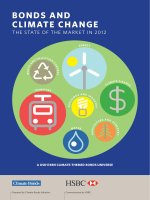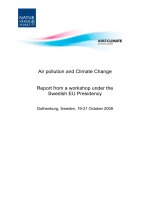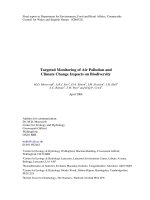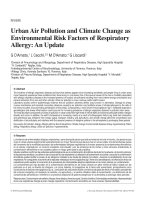Global warming and climate change demystified by jerry silver (306 pages, 2008)
Bạn đang xem bản rút gọn của tài liệu. Xem và tải ngay bản đầy đủ của tài liệu tại đây (6.61 MB, 306 trang )
Global Warming
and Climate Change
Demystified
Demystified Series
Accounting Demystified
Advanced Calculus Demystified
Advanced Physics Demystified
Advanced Statistics Demystified
Algebra Demystified
Alternative Energy Demystified
Anatomy Demystified
asp.net 2.0 Demystified
Astronomy Demystified
Audio Demystified
Biology Demystified
Biotechnology Demystified
Business Calculus Demystified
Business Math Demystified
Business Statistics Demystified
C++ Demystified
Calculus Demystified
Chemistry Demystified
Circuit Analysis Demystified
College Algebra Demystified
Corporate Finance Demystified
Data Structures Demystified
Databases Demystified
Diabetes Demystified
Differential Equations Demystified
Digital Electronics Demystified
Earth Science Demystified
Electricity Demystified
Electronics Demystified
Engineering Statistics Demystified
Environmental Science Demystified
Everyday Math Demystified
Fertility Demystified
Financial Planning Demystified
Forensics Demystified
French Demystified
Genetics Demystified
Geometry Demystified
German Demystified
Global Warming and Climate Change Demystified
Hedge Funds Demystified
Home Networking Demystified
Investing Demystified
Italian Demystified
Java Demystified
JavaScript Demystified
Lean Six Sigma Demystified
Linear Algebra Demystified
Macroeconomics Demystified
Management Accounting Demystified
Math Proofs Demystified
Math Word Problems Demystified
MATLAB® Demystified
Medical Billing and Coding Demystified
Medical Terminology Demystified
Meteorology Demystified
Microbiology Demystified
Microeconomics Demystified
Nanotechnology Demystified
Nurse Management Demystified
OOP Demystified
Options Demystified
Organic Chemistry Demystified
Personal Computing Demystified
Pharmacology Demystified
Physics Demystified
Physiology Demystified
Pre-Algebra Demystified
Precalculus Demystified
Probability Demystified
Project Management Demystified
Psychology Demystified
Quality Management Demystified
Quantum Mechanics Demystified
Real Estate Math Demystified
Relativity Demystified
Robotics Demystified
Sales Management Demystified
Signals and Systems Demystified
Six Sigma Demystified
Spanish Demystified
SQL Demystified
Statics and Dynamics Demystified
Statistics Demystified
Technical Analysis Demystified
Technical Math Demystified
Trigonometry Demystified
UML Demystified
Visual Basic 2005 Demystified
Visual C# 2005 Demystified
Vitamins and Minerals Demystified
XML Demystified
Global Warming
and Climate Change
Demystified
Jerry Silver
New York Chicago San Francisco Lisbon London
Madrid Mexico City Milan New Delhi San Juan
Seoul Singapore Sydney Toronto
Copyright © 2008 by The McGraw-Hill Companies, Inc. All rights reserved. Except as permitted under the United States Copyright Act of 1976, no
part of this publication may be reproduced or distributed in any form or by any means, or stored in a database or retrieval system, without the prior
written permission of the publisher.
ISBN: 978-0-07-160118-4
MHID: 0-07-160118-X
The material in this eBook also appears in the print version of this title: ISBN: 978-0-07-150240-5, MHID: 0-07-150240-8.
All trademarks are trademarks of their respective owners. Rather than put a trademark symbol after every occurrence of a trademarked name, we use
names in an editorial fashion only, and to the benefit of the trademark owner, with no intention of infringement of the trademark. Where such designations appear in this book, they have been printed with initial caps.
McGraw-Hill eBooks are available at special quantity discounts to use as premiums and sales promotions, or for use in corporate training programs.
To contact a representative please e-mail us at
Information contained in this work has been obtained by The McGraw-Hill Companies, Inc. (“McGraw-Hill”) from sources believed to be reliable.
However, neither McGraw-Hill nor its authors guarantee the accuracy or completeness of any information published herein, and neither McGraw-Hill
nor its authors shall be responsible for any errors, omissions, or damages arising out of use of this information. This work is published with the understanding that McGraw-Hill and its authors are supplying information but are not attempting to render engineering or other professional services. If
such services are required, the assistance of an appropriate professional should be sought.
TERMS OF USE
This is a copyrighted work and The McGraw-Hill Companies, Inc. (“McGraw-Hill”) and its licensors reserve all rights in and to the work. Use of this
work is subject to these terms. Except as permitted under the Copyright Act of 1976 and the right to store and retrieve one copy of the work, you may
not decompile, disassemble, reverse engineer, reproduce, modify, create derivative works based upon, transmit, distribute, disseminate, sell, publish
or sublicense the work or any part of it without McGraw-Hill’s prior consent. You may use the work for your own noncommercial and personal use;
any other use of the work is strictly prohibited. Your right to use the work may be terminated if you fail to comply with these terms.
THE WORK IS PROVIDED “AS IS.” McGRAW-HILL AND ITS LICENSORS MAKE NO GUARANTEES OR WARRANTIES AS TO THE
ACCURACY, ADEQUACY OR COMPLETENESS OF OR RESULTS TO BE OBTAINED FROM USING THE WORK, INCLUDING ANY
INFORMATION THAT CAN BE ACCESSED THROUGH THE WORK VIA HYPERLINK OR OTHERWISE, AND EXPRESSLY DISCLAIM
ANY WARRANTY, EXPRESS OR IMPLIED, INCLUDING BUT NOT LIMITED TO IMPLIED WARRANTIES OF MERCHANTABILITY OR
FITNESS FOR A PARTICULAR PURPOSE. McGraw-Hill and its licensors do not warrant or guarantee that the functions contained in the work will
meet your requirements or that its operation will be uninterrupted or error free. Neither McGraw-Hill nor its licensors shall be liable to you or
anyone else for any inaccuracy, error or omission, regardless of cause, in the work or for any damages resulting therefrom. McGraw-Hill has no
responsibility for the content of any information accessed through the work. Under no circumstances shall McGraw-Hill and/or its licensors be liable
for any indirect, incidental, special, punitive, consequential or similar damages that result from the use of or inability to use the work, even if any of
them has been advised of the possibility of such damages. This limitation of liability shall apply to any claim or cause whatsoever whether such claim
or cause arises in contract, tort or otherwise.
This book is dedicated to my wife, Joanie, who is, and
has always been, ready to take the next positive step,
and to Ally and Danny, whose future grandchildren
deserve to inherit a stable planet.
ABOUT THE AUTHOR
Jerry Silver has worked for nearly two decades supporting the development and
manufacturing of solar cells. He was a design engineer for solar arrays used to
provide power for commercial and NASA satellites. He holds a B.S. in Engineering
Physics from Cornell University and a M.S. in Physics from the University of
Massachusetts. Mr. Silver currently teaches science in New Jersey.
CONTENTS AT A GLANCE
CHAPTER 1
Global Perspective—Thinking about the Earth
1
PART ONE
WHAT WE KNOW AND HOW WE KNOW IT
CHAPTER 2
Taking the Earth’s Temperature
CHAPTER 3
Signs of Global Warming
PART TWO
WHY CLIMATE CHANGES
CHAPTER 4
The Earth’s Thermostat—Keeping the Earth Warm
CHAPTER 5
Greenhouse Chemistry
107
CHAPTER 6
Origin and Impact of Greenhouse Gases
127
PART THREE
WHAT WE CAN EXPECT AND WHAT
WE CAN DO
CHAPTER 7
Consequences of Global Warming
151
CHAPTER 8
Resetting the Earth’s Thermostat—Solutions
185
Final Exam
231
APPENDIX A
Glossary
247
APPENDIX B
Milestones in the History of Climate Change
251
APPENDIX C
Satellites That Monitor Weather and Climate
255
7
33
69
viii
Global Warming and Climate Change Demystified
APPENDIX D
Units of Measurement Applied to Climate Change 259
APPENDIX E
Selected Resources
263
APPENDIX F
Summary of Key Climate Variables
265
APPENDIX G
Lingering Doubts and Concerns
269
APPENDIX H
Answers to Chapter Review Questions
273
APPENDIX I
Answers to Final Exam
275
Index
277
CONTENTS
Acknowledgments
xiii
CHAPTER 1
Global Perspective—Thinking about the Earth
PART ONE
WHAT WE KNOW AND HOW WE KNOW IT
CHAPTER 2
Taking the Earth’s Temperature
Global Temperature Measurement—The Basics
How Is the Earth’s Temperature Changing?
Going Back in Time—The Next Best Thing
to Having a Thermometer
Different Places, Different Temperature Changes
What the Data Are Telling Us
Cause and Effect
Key Ideas
Review Questions
15
22
27
28
28
29
Signs of Global Warming
Direct and Indirect Evidence
The Oceans
Melting Ice and Snow
Impact on Wildlife—Some Examples
Wacky Weather
Key Ideas
Review Questions
33
33
34
41
55
57
63
64
CHAPTER 3
1
7
8
10
x
Global Warming and Climate Change Demystified
PART TWO
WHY CLIMATE CHANGES
CHAPTER 4
The Earth’s Thermostat—Keeping the Earth Warm 69
The Earth’s Orbit
70
How the Sun Warms the Earth
71
Natural Climate Cycles
90
Distribution of Heat around the
Earth—Thermohaline Circulation
and the Gulf Stream
101
Key Points
103
Review Questions
104
CHAPTER 5
Greenhouse Chemistry
Gases in the Atmosphere
Generating Carbon Dioxide
Absorption of Light by Gases in the Atmosphere
Trace Gases with a Major Potential Impact
Carbon Sinks
Comparison of Fuels
The Effect of Increasing Concentration
Isotopes—Determining How Old Something Is
Key Ideas
Review Questions
107
108
108
111
114
116
117
120
121
123
124
CHAPTER 6
Origin and Impact of Greenhouse Gases
What People Add to Nature’s Greenhouse
How Do We Know Where the Greenhouse Gases
Come From? Human Fingerprints versus
Nature’s Pawprints
How the Greenhouse Gases Affect
the Atmosphere
Where the Human-Added Greenhouse Gases
Come From
World Energy Use
Defining the Problem—Key Ideas
Review Questions
127
128
135
137
141
144
146
147
xi
Contents
PART THREE
WHAT WE CAN EXPECT AND WHAT
WE CAN DO
CHAPTER 7
Consequences of Global Warming
Climate Models
How Much and How Soon Will Climate Change?
Impacts of Climate Change
Regional Climate Changes
Back to the Future—Will the Past Repeat Itself?
Results of Climate Models—Levels of Certainty
Key Ideas
Review Questions
151
151
157
165
167
170
173
180
181
CHAPTER 8
Resetting the Earth’s Thermostat—Solutions
Electrical Power: The Problem with Coal
Transportation—The Problem with Oil
Steps Toward a Solution
Stepping Up to the Plate—Taking Action
Emissions Trading—Cap and Trade
Turing Your Money “Green”
Adaptation—Global Band-Aids
So Crazy It Just Might Work
What You Can Do—Individual Actions
Final Thoughts
Key Ideas
Review Questions
185
186
203
210
212
218
219
219
220
223
225
226
227
Final Exam
231
APPENDIX A
Glossary
247
APPENDIX B
Milestones in the History of Climate Change
251
APPENDIX C
Satellites That Monitor Weather and Climate
255
APPENDIX D
Units of Measurement Applied to Climate Change 259
Temperature Units
260
Measurement of Wavelength
260
xii
Global Warming and Climate Change Demystified
Energy and Power
Examples of the Use of Prefixes
260
261
APPENDIX E
Selected Resources
Publications
Web Sites
263
263
263
APPENDIX F
Summary of Key Climate Variables
265
APPENDIX G
Lingering Doubts and Concerns
269
APPENDIX H
Answers to Chapter Review Questions
273
APPENDIX I
Answers to Final Exam
275
Index
277
ACKNOWLEDGMENTS
The author would like to thank Judy Winchock, Bob Moshman, the Kaolins, and
Joan Silver for their help with the text. Grateful recognition also goes to the many
dedicated men and women around the world who have collected and assembled the
scientific data that this book is based on.
This page intentionally left blank
Global Warming
and Climate Change
Demystified
This page intentionally left blank
CHAPTER 1
Global Perspective—
Thinking about
the Earth
To fully understand how the earth’s climate is changing, it is important to maintain
a global perspective. Conclusions about the earth’s climate are based on small
changes to global averages viewed in the context of the entire history of the earth.
Collecting the data is a massive effort requiring the collaboration of many scientists
around the world. It is understandable how people looking at parts of this data in
isolation, can arrive at different conclusions.
In the time it takes to read a few pages of this book, the temperature outside
easily may have changed by more than the total average global temperature increase
for the entire past century. The rise and fall of the ocean during any given hour far
exceeds the overall average global increase in sea level for an entire decade.
2
Global Warming and Climate Change Demystified
Over the last hundred years, the earth’s average temperature has increased by
about three quarters of a degree Centigrade (1.3°F). This seemingly minor change
may strike some people as inconsequential. However, if global warming adds just
another 4°C (7°F) or so to the atmospheric temperature, both Greenland and
Antarctica could be well on their way to meltdown. A far more conspicuous
confirmation that the earth’s climate is changing can be seen around the world in the
rapid melting of glaciers and ice sheets that had been around for thousands of
years.
It is like the scene from the movie, Jurassic Park, where the tour guide notices
the very first tremors in a glass of water caused by the approaching Tyrannosaurus
Rex. The tremors in the earth’s climate may be barely detectable at first, but have
the potential to reshape our entire planet. How should we respond to these early
warning signs? If the earth were a machine shop in Osaka, or a semiconductor
processing line in Palo Alto, it would be shut down for being statistically out of
control. The sky is not falling just yet; but there may be a very small window of
opportunity between when we detect the early warning signs and when it is too late
to respond effectively.
One way to define progress is how the world deals with what it needs to dispose
of. The industrialized world has progressed in how it has handled sewage treatment,
recycling, and reducing sulfur emissions that cause acid rain. Lead was removed
from gasoline. Mercury is being captured from smokestacks. Chemicals that destroy
ozone were replaced. The American eagle, once threatened by pesticides, was just
taken off the endangered species list in 2007. With each success story, there was no
doubt someone who insisted that the solutions were unnecessary and would be too
expensive. Greenhouse gases are the world’s next challenge. The key questions are:
In whose backyard will the solutions be located and how much will it cost? Costs
can also be put in perspective and weighed against the prospect of living on a planet
where greenhouse gas levels continue to be driven off the charts.
Many of the insights about climate change described in this book are the result
of work performed by scientists working with The Intergovernmental Panel on
Climate Change (IPCC). The IPCC, along with Al Gore, won the 2007 Nobel Peace
Prize. This choice by the Nobel committee reflects the belief that the consequences
of drastic climate change could lead to instability around the world with an increased
risk of conflict.
This book is organized into three parts. Part One is called “What We Know and
How We Know It.” The starting point for understanding climate change comes from
the basic scientific processes of measurement and observation. Scientists around
the world have painstakingly collected data from weather instruments, satellite
telemetry, ice cores, and coral sections. This book will explore how those data are
collected and analyzed.
CHAPTER 1
Thinking about the Earth
3
Next comes Part Two, which is called “Why Climate Changes.” The temperature
of the earth is the result of well-understood physical processes. Nature is responsible
for many climate changes. However, the carbon dioxide that humans have generated
from fossil fuel combustion can be considered is a natural atmospheric component
at unnatural levels. Greenhouse gas concentrations have never been this high before,
and this book will examine their impact.
Part Three is called “What We Can Expect and What We Can Do.” No single
country is responsible for the climate changes that are occurring, and no single
country can reverse them single-handedly. However, to stabilize the earth’s
temperature, countries around the world may need to fundamentally rethink how
they use energy—a process that, for several reasons, may be long overdue. This
section will also address the tools that scientists use to forecast climate changes in
the future.
The science fiction writer Robert A. Heinlein said, “Climate is what you expect;
weather is what you get.” Global Warming and Climate Change Demystified is
intended to help guide the reader to a better understanding of what to expect from
the changes that have begun to take place.
This page intentionally left blank
PART ONE
What We Know and
How We Know It
This page intentionally left blank
CHAPTER 2
Taking the Earth’s
Temperature
Science typically starts with measurement. This chapter is about the data that
scientists around the world use to form judgments about climate change. We will
discuss how measurements are made and how they are assembled to characterize
the climate of the entire earth. There is more than one type of temperature-measuring
instrument in the climate scientist’s toolkit. These include direct measurements
such as thermometers on the earth’s surface, ships and buoys at sea, and balloons
released into the atmosphere. Satellites in earth orbit currently are providing a much
more comprehensive thermal profile of the earth’s surface and atmosphere. Scientists
also do detective work to investigate what the earth’s climate was like as far back
as hundreds of thousands of years ago. We know that global warming is occurring
because that is what the data shows. Let’s start by taking a look at where the data
comes from.
8
Global Warming and Climate Change Demystified
Global Temperature Measurement—The Basics
Of the various ways to measure the earth’s temperature, the simplest and most
straightforward method is to use a thermometer. Galileo developed the first known
thermometer in the early 1600s. His thermometer was crude by today’s standards
and only narrowed air temperature readings to a fairly broad temperature range. But
this was a start. Experimenters in Europe introduced liquid-filled bulb thermometers
that were more reliable and accurate. In 1714, Gabriel Fahrenheit invented the first
mercury thermometer, and it became the first established method for tracking the
changes that the earth’s climate was beginning to experience.
There is no single location where we can place a thermometer to measure
the entire earth’s temperature. During the last few centuries, local weather
agencies established what has become a network of temperature-collection
stations scattered throughout the world, such as the one pictured in Figure 2-1.
Groups collecting these data created standards, such as how high above the
ground measurements were taken, and specified the use of ventilated
enclosures. Ships and buoys made measurements of air temperatures above
the ocean. During the 1940s, explorers ventured into the polar regions to
collect temperature readings that are now represented routinely in the global
temperature measurements.
New measurement locations were added continuously to the database, and
measurement techniques became more refined. As this happened, scientists did not
want the evolution of the measurement network itself to affect the consistency of
the global averages they were trying to measure. To prevent this, the groups tracking
the data incorporated the use of anomalies, which refer to departures from an
established local temperature range. The change in temperature compared with
some previous level is called an anomaly. Uncertainties in measurement are most
likely to affect the absolute temperature reading—or the actual number of degrees
a particular station was reading. Tracking anomalies makes it easier to answer the
overriding question of how the temperature is changing at a given location. Scientists
then can talk about how much a particular reading is above or below normal.
Anomaly tracking is also used to reduce the possibility of calibration errors with
ocean temperature monitoring and with sea-level measurements, as we will see in
the following chapters.
Today, over 7000 stations spanning the earth, over both land and the oceans,
perform temperature measurements (Figure 2-2).
Three major organizations collect and compile temperature data to generate
global averages:









